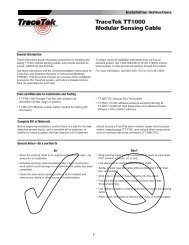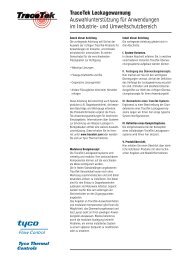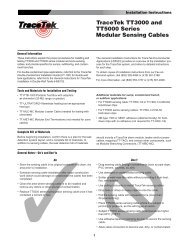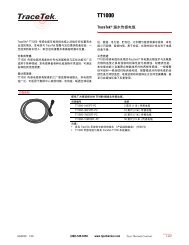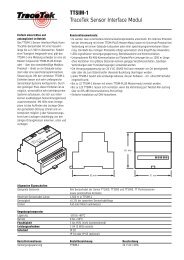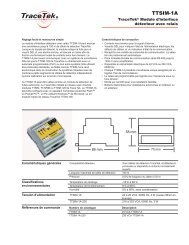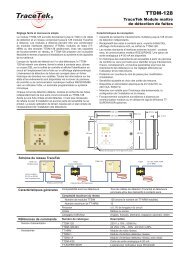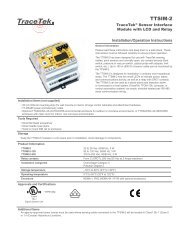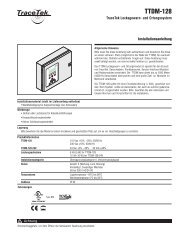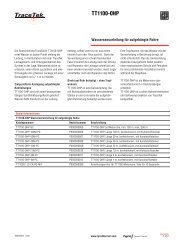TraceTek Leak Detection Product Selection Guide for Industrial and ...
TraceTek Leak Detection Product Selection Guide for Industrial and ...
TraceTek Leak Detection Product Selection Guide for Industrial and ...
Create successful ePaper yourself
Turn your PDF publications into a flip-book with our unique Google optimized e-Paper software.
II. Determining the Monitoring Approach<br />
Determining the monitoring approach<br />
<strong>for</strong> leak detection means making three<br />
key choices about scope:<br />
• Areas or operations to have<br />
separate alarm <strong>and</strong>/or control<br />
• Types of systems (see Table 1 <strong>for</strong><br />
details on the different types of<br />
<strong>TraceTek</strong> alarm modules).<br />
• Extent of leak detection coverage<br />
When deciding, consider these<br />
important aspects of your application:<br />
the geometry, the response required to<br />
an alarm, the liquids to be detected,<br />
<strong>and</strong> the risks involved.<br />
Geometry/layout<br />
Application geometry is key in<br />
determining the type of alarm module<br />
<strong>and</strong> number of units to use. Aspects of<br />
the application layout to consider include<br />
size (length or area), separation (the<br />
number of separate pipes or areas), <strong>and</strong><br />
accessibility.<br />
Response<br />
When a leak occurs, consider how your<br />
organization must respond. If different groups<br />
are responsible <strong>for</strong> different equipment,<br />
systems, or areas, use separate <strong>TraceTek</strong><br />
alarm modules to make ownership clear.<br />
If you plan to use a <strong>TraceTek</strong> alarm module<br />
<strong>for</strong> direct equipment control (<strong>for</strong> example, to<br />
close a valve when a leak is detected),<br />
select a module with relay logic that will<br />
provide the desired operation, <strong>and</strong> use<br />
separate modules to control separate<br />
equipment.<br />
Liquids to detect<br />
Different types of <strong>TraceTek</strong> sensing cables<br />
are available to detect different types of liquids,<br />
as summarized in Table 2. To select a<br />
sensing cable to detect a liquid not mentioned<br />
in Table 2 or the product data sheets,<br />
call Raychem <strong>for</strong> assistance. The sensing<br />
cables listed are compatible with all of the<br />
alarm modules, <strong>and</strong> multiple types of cables<br />
may be used in a single sensing circuit.<br />
Risks<br />
When deciding on the leak detection<br />
coverage <strong>for</strong> your application, take into<br />
account the potential impact of a leak or<br />
spill, which could include injury, damage,<br />
cleanup costs, downtime, <strong>and</strong> liability. Also<br />
consider the likelihood of leaks or spills,<br />
which depends heavily on application<br />
specifics, such as the degree of exposure<br />
<strong>and</strong> the nature of the operations (the<br />
materials h<strong>and</strong>led, level of activity,<br />
maintenance practices).<br />
Hazardous locations<br />
If h<strong>and</strong>ling flammables, select <strong>TraceTek</strong><br />
alarm modules <strong>and</strong> a system layout that<br />
will meet the approval requirements <strong>for</strong><br />
your hazardous locations.<br />
Table 1. <strong>TraceTek</strong> Alarm Modules—Summary of Features<br />
Type of System Locating Multiple- Singlechannel<br />
alarm<br />
channel alarm<br />
<strong>TraceTek</strong> Alarm Module TTDM TTG TTA-1 TTC-1<br />
<strong>Leak</strong> detection coverage<br />
Areas Number of branches/areas limited 4 with TTG-4 1 1<br />
only by length of sensing circuit 12 with TTG-12<br />
Max. sensing cable length 5000 ft (1500 m) 100 ft (30 m) per channel 100 ft (30 m) 100 ft (30 m)<br />
Alarm relays<br />
Type of Form C relay DPDT DPDT DPDT 4PDT 4PDT DPDT SPDT<br />
Triggered by <strong>Leak</strong> Serv. req'd. Fault <strong>Leak</strong> or fault on any channel <strong>Leak</strong> or fault <strong>Leak</strong> Trouble<br />
Communication Relays, 4–20 mA analog, <strong>and</strong> Relay Relay Relays<br />
with host systems<br />
RS-232 or RS-485, Modbus<br />
Enclosure rating NEMA 12 NEMA 13 NEMA 1 NEMA 1<br />
Hazardous location usage*<br />
Module location Ordinary areas Ordinary areas or CID2 Ordinary areas Ordinary areas<br />
or CID2<br />
Sensing cable location Ordinary areas or CID2. Ordinary areas, CID2, or CID1 Ordinary areas, Ordinary areas<br />
CID1, if protected by approved<br />
CID2, or CID1<br />
zener safety barrier.<br />
*See data sheets <strong>for</strong> details on approvals. CIDI st<strong>and</strong>s <strong>for</strong> Class I, Division 1, CID2 st<strong>and</strong>s <strong>for</strong> Class I Division 2 hazardous locations.<br />
Note: For additional in<strong>for</strong>mation, see page 5 of this guide or refer to the applicable product data sheets <strong>for</strong> complete detail.<br />
Table 2. <strong>TraceTek</strong> Sensing Cables<br />
Sensing cable Liquids detected Liquids ignored<br />
TT3000 Aqueous solutions <strong>and</strong> other conductive liquids Fuels <strong>and</strong> oils<br />
TT5000 Fuels <strong>and</strong> oils: gasoline, diesel fuel, jet fuel, heating Water <strong>and</strong> aqueous solutions<br />
oil, motor oil, hydraulic fluid, <strong>and</strong> other hydrocarbons<br />
TT5001 Organic solvents: acetone, MEK, NMP, TCA, TCE Water <strong>and</strong> aqueous solutions<br />
Notes: These sensing cables are compatible with any of the <strong>TraceTek</strong> alarm modules.<br />
Multiple types of cables may be used in a single sensing circuit.<br />
2



